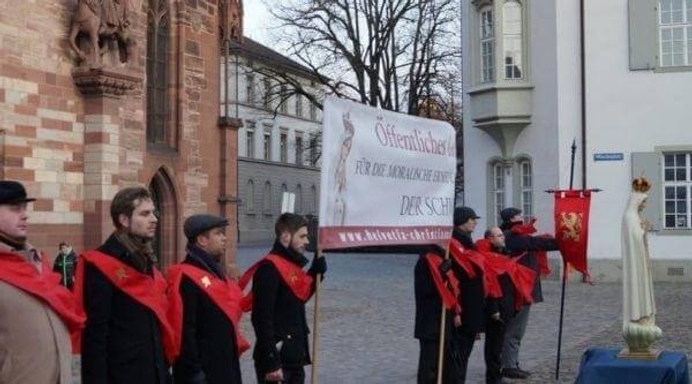
Public Rosary in Switzerland
In front of the historic cathedral of Basel, about fifty Catholics publicly prayed a Rosary chaplet for the restoration of the Catholic faith in Switzerland. Of them, 35 were local residents who were joined by young volunteers of ours from France, the United States and Poland.
Thus, perhaps for the first time since the day that Switzerland fell under Protestant rule, the Rosary was again prayed in such a symbolic place.
Indeed, the medieval cathedral of Basel - a Swiss city on the banks of the Rhine - is one of the oldest historical relics in the country. It succeeds several Catholic cathedrals built over the centuries since the Carolingian era (8th and 9th centuries). In 917 it was plundered and looted by the Hungarians, who were still barbarians. In 1019 it was rebuilt and enlarged with the support of the emperors (saint) Henry II and Adalbert II. Between 1185 and 1230 a new building was constructed in Roman style, and from 1270 to 1285, the western portal was built in flaming Gothic style.
The most important funerary monument housed by the cathedral is that of Queen Anne of Habsburg, born Gertrud von Hohenberg around 1225, and buried with her son Charles. Around 1253 she married Count Rudolf of Habsburg and the couple was crowned as kings of the Romans at Aix-la-Chapelle in 1273.
Consecrated to the Blessed Virgin Mary, from 1347 the cathedral had Henry II as secondary patron. Then the relics of this holy emperor’s wife were transferred from the cathedral of Bamberg (Germany) to that of Basel. In 1356, the cathedral was damaged by a violent earthquake that destroyed its western portal. A long and laborious work of restoration of the Gothic cathedral then began, which lasted until 1500.
On February 9, 1529, a much more serious earthquake, of a spiritual nature, destroyed the Catholic faith: the so-called Protestant Reformation seized the cathedral and soon afterward the whole country.
